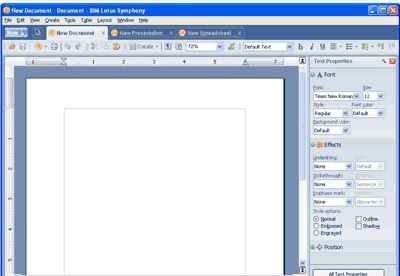

- #Lotus symphony program Pc
- #Lotus symphony program windows
#Lotus symphony program Pc
The introduction of the US IBM PC 104-key keyboard and later ergonomic keyboards diluted this advantage.Ĭompared to other word processors of the day such as Micropro WordStar 3.3, WordPerfect 4.2, and Microsoft Word 2.0, Symphony's word processing environment was simple, but effective and uncomplicated.Ĭompared to other database programs of the day- Ashton-Tate's dBase III, MDBS Knowledgeman, Borland Paradox 2.0 and Borland Reflex 1.0-Symphony's FORM environment was not as robust, lacking the analytical abilities of Reflex and the pseudo relational power of dBase III. In this way, the user could use both hands to select menu functions, navigate menus and spreadsheets, as well as, all other Symphony functions by touch. Symphony put the power of the spreadsheet at the user's fingertips and used all of the available keys on IBM's 84-key PC keyboard.
 The ability to copy "to a location" and end up at that location, instead of at the copy "from location.". The addition of the TAB key to anchor ranges, instead of just using the period key. Multiple menu systems, retaining 1-2-3's uniquely identified first-character menu items. Additional formula functions building on 1-2-3's spreadsheet only formulas. A rearranged worksheet menu, placing COPY as the first menu item, then the other most frequently used items after that. The ability to create unique application looking spreadsheets using customizable macro driven menus and display Windows, the result being menu driven applications that, to the user, resembled little of their original spreadsheet heritage. Symphony's spreadsheet engine was similar to, but not the same as the one used in Lotus 1-2-3, once the most popular of its kind. Similar and competitive packages included SmartWare, Microsoft Works, Context MBA, Framework, Enable and Ability Office. Symphony was designed to work completely in the standard 640k of conventional memory, supplemented by any expanded memory. The other environments-word processing, database, communications, graphics-in essence only change the display format and focus of that data (including available menus, special keys, and functionality), which can be saved and retrieved as. The user is then able to see that changes made in one environment are reflected in others simultaneously, perhaps the package's most interesting feature.Īll the data that Symphony handles is kept in spreadsheet-like cells. The program allows the screen to be split into panes and distinct Windows, showing different views of the underlying data simultaneously, each of which can display any of the five environments. Several "add-in applications" can be "attached" and activated, extending Symphony's capabilities, including a powerful macro manager, a document outliner, a spell-checker, statistics, various communications configurations, and a tutorial, which demonstrates Symphony usage by running macros. FORM, a table-based database management system. SHEET, a spreadsheet program very similar to 1-2-3. Using ALT+F10 the user can alternate among the five "environments" of the program, each a rendering of the same underlying data.
The ability to copy "to a location" and end up at that location, instead of at the copy "from location.". The addition of the TAB key to anchor ranges, instead of just using the period key. Multiple menu systems, retaining 1-2-3's uniquely identified first-character menu items. Additional formula functions building on 1-2-3's spreadsheet only formulas. A rearranged worksheet menu, placing COPY as the first menu item, then the other most frequently used items after that. The ability to create unique application looking spreadsheets using customizable macro driven menus and display Windows, the result being menu driven applications that, to the user, resembled little of their original spreadsheet heritage. Symphony's spreadsheet engine was similar to, but not the same as the one used in Lotus 1-2-3, once the most popular of its kind. Similar and competitive packages included SmartWare, Microsoft Works, Context MBA, Framework, Enable and Ability Office. Symphony was designed to work completely in the standard 640k of conventional memory, supplemented by any expanded memory. The other environments-word processing, database, communications, graphics-in essence only change the display format and focus of that data (including available menus, special keys, and functionality), which can be saved and retrieved as. The user is then able to see that changes made in one environment are reflected in others simultaneously, perhaps the package's most interesting feature.Īll the data that Symphony handles is kept in spreadsheet-like cells. The program allows the screen to be split into panes and distinct Windows, showing different views of the underlying data simultaneously, each of which can display any of the five environments. Several "add-in applications" can be "attached" and activated, extending Symphony's capabilities, including a powerful macro manager, a document outliner, a spell-checker, statistics, various communications configurations, and a tutorial, which demonstrates Symphony usage by running macros. FORM, a table-based database management system. SHEET, a spreadsheet program very similar to 1-2-3. Using ALT+F10 the user can alternate among the five "environments" of the program, each a rendering of the same underlying data. #Lotus symphony program windows
pif file, Symphony can also be used on Windows XP and its successors. Symphony for MS-DOS is a program that loads entirely into memory on startup, and can run as an MS-DOS task on versions of Microsoft Windows (3.x/95/98/ME). Other products described as "integrated", such as Ashton-Tate's Framework and AppleWorks, from Apple Computer, normally included word processor functionality. Lotus 1-2-3 had originally been billed as an integrated product with spreadsheet, database and graphing functions (hence the name "1-2-3").






 0 kommentar(er)
0 kommentar(er)
